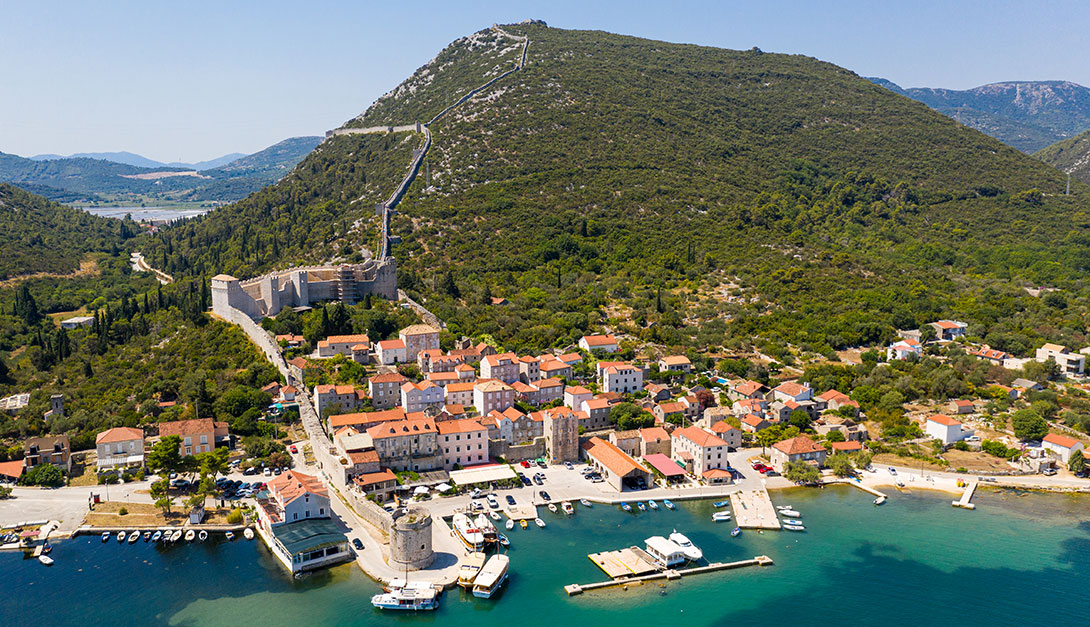7 TOP things to do when sailing to Pelješac
8. November, 2024
Discover Pelješac: 7 Top Things to Do on Your Croatian Sailing Adventure
Pelješac is a stunning peninsula in southern Croatia, situated along the Adriatic Sea in the Dalmatia region. It is the second-largest peninsula in Croatia, extending approximately 65 kilometres (40 miles) from Ston to the small town of Lovište.

Pelješac is also an idyllic sailing destination that offers much to see and discover.
Pelješac is known for many things, especially its breathtaking coastline, winds, crystal-clear waters, wine, oysters, salt farms, and charming historical towns. Pelješac is unique in its seamless blend of natural beauty and rich cultural heritage, offering every visitor a unique experience.
The Pelješac peninsula can genuinely be said to have it all. Are you into history and culture? No problem: museums, old fortresses, picturesque churches, and city centres exist. But that's not all. Are you interested in Paradise Beaches? Plenty of them are in Pelješac; you can explore them for months. Do you like an active holiday? Water sports, especially sailing, surfing, and kitesurfing, are to be found on this peninsula as one of the most popular sports due to its famous windy spots. The variety of activities in Pelješac will keep you on your toes and ready for adventure.
For those with a taste for the finer things, Pelješac is a culinary paradise. The peninsula has many wineries, each producing unique, top-quality wines. Mediterranean cuisine and fresh shellfish from local farms delight the taste buds, offering a truly authentic dining experience. Indulge in the culinary delights of Pelješac and satisfy your cravings for exquisite food and wine. Pelješac, the homeland of sailors, mistral wind, oysters, and wine, is steeped in history. Its past is a testament to the resilience and ingenuity of its people, making it a destination rich in heritage and culture.
Here are 7 TOP things to do when sailing to Peljesac in Croatia:
1) Ston: Walk Along the Walls of Ston

At the stunning tip of the peninsula lies the enchanting town of Ston, connected to Mali Ston by the magnificent Ston Walls, Europe's longest preserved stone wall. Picture a Mediterranean haven with its picturesque stone streets, quaint houses, ancient churches, and historic forts framed by the majestic walls above. Spanning 5.5 kilometres today—just 1.5 kilometres shorter than during the glory days of the Republic of Dubrovnik—these walls are incredibly well-preserved and offer an unforgettable experience. Wearing comfortable shoes is essential, and while some fitness is needed, the reward of exploring this captivating location is worth the effort!
2) Saltworks in Ston
Additionally, the town is home to the famous Ston saltworks, where visitors can observe the production of some of Croatia's highest-quality salt and the gourmet salt flower.

Salt from Ston
Saltworks in Ston is one of three saltworks in Croatia, the oldest in Europe and possibly the world. It originated in the 14th century and is still in use today. It was created after the Republic of Dubrovnik bought Ston in 1333 and surrounded it with a defensive wall in 1360. Ston became the ideal location for the saltworks, which brought the Republic the most income, 15,900 ducats per year. Many provisions precisely regulate the production and trade of salt in the territory of the Republic. The highest profit was achieved in the year 1611. The salt pan is divided into basins named after a Christian saint except Munda. Solana has kept its appearance and production method the same. In 2007, 530 tons of salt, about 59 tons per pool, were washed in 9 crystallization pools in Ston.

3) Try The Best Risotto with Cuttlefish Ink (Crni Rižot) In The World
The famous restaurant named Captain's House is located on the Maloston waterfront (Obala Dr. Ante Starčevića 9), where it used to be the harbour captain's headquarters during the Republic of Dubrovnik. Lidija Kralj, a famous Croatian chef and a memorable face on TV screens, owns and manages the Captain's House. They focus on fish and seafood, grow vegetables in their own garden, and produce their own olive oil. In addition to the Captain's House restaurant, open every day from noon to 10 p.m., they also own the Ostrea Hotel.
Maloston Bay is renowned for its shellfish cultivation, which can be enjoyed in many excellent restaurants and taverns throughout Ston. Lidija Kralj's risotto with cuttlefish ink is a culinary masterpiece that beautifully captures the essence of Croatian coastal cuisine. This dish is often prepared in picturesque coastal towns, where the flavours of the Adriatic Sea come alive.

The risotto is characterized by its deep black hue, which comes from the rich, briny ink of the cuttlefish. Lidija sources fresh cuttlefish from local fishermen, ensuring the highest quality and flavour. The dish begins with a base of sautéed onions and garlic, which provides a fragrant foundation. Next, Arborio rice is added and toasted lightly to enhance its nuttiness. Gradually, homemade seafood broth is incorporated, allowing the rice to absorb the liquid slowly, achieving that creamy texture that risotto is known for.
The addition of the cuttlefish ink not only colours the dish but also infuses it with a rich, oceanic flavour that pairs perfectly with the sweetness of the cuttlefish, which is added towards the end of cooking. To finish, Lidija garnishes the risotto with a sprinkle of freshly chopped parsley and a drizzle of high-quality olive oil. This dish is typically served with lemon wedges, allowing diners to brighten the flavours with acidity. Enjoyed in a quaint seaside restaurant or family gathering, Lidija Kralj's risotto with cuttlefish ink reflects Croatia's culinary heritage, celebrating the sea's bounty with every sumptuous bite.
4) Visit Orebic: A Place of Sailors and the Most Beautiful Viewpoint

The most prominent place on the peninsula is at its very end and is connected by a regular boat line to Korcula, which is only a ten-minute drive away. Orebić and its surroundings are known for the most beautiful beaches in Croatia, vineyards and olive groves, and the town has a rich maritime history. In Orebić, you must visit the Maritime Museum and the Museum of the Franciscan Monastery with votive paintings of sailors and their families. As part of the monastery, there is a small church and a viewpoint of Our Lady of Anđela, which offers the most beautiful view of the city and the entire bay.
Marina Orebić, Pelješac

Marina Orebić is a picturesque marina in Orebić. It is renowned for its stunning natural beauty, featuring clear blue waters, lush greenery, and the majestic backdrop of Mount Srđ. The marina is a gateway for sailors and boating enthusiasts eager to explore the beautiful Dalmatian coast and nearby islands, such as Korčula. Orebić is rich in history and culture; it was a prominent maritime centre during the 19th century. Visitors can enjoy exploring the town's historic architecture, including the Franciscan Monastery, and savouring local cuisine that highlights fresh seafood and regional wines, particularly those from the famous vineyards of Pelješac.
The marina is well-equipped and offers a range of services for boaters, including mooring, maintenance, and fuel supplies. With its friendly atmosphere and stunning surroundings, Marina Orebić is ideal for relaxation and adventure in one of Croatia's most beautiful coastal regions.
5) Visit Viganj: Paradise for Those Who Love Wind Hunt

Windsurfers, kitesurfers and sailing enthusiasts from all over the world gather in a small town near Orebić. Viganj is located eight kilometres west of Orebić along the narrowest part of the Pelješka channel, where, due to the narrow passage, the wind is always ideal for water activities. The most famous beach in Viganj is Ponti Liberan, where you can rent equipment, take an instructor or ride the waves independently. Even if you don't want to try the sport yourself, seeing the endless row of sails in the sea leaves you breathless! In the village, visiting the former Dominican monastery Kuvenat, which houses a cultural centre today, is still worth visiting. Next to Viganj is also the charming town of Nakovana, one of the oldest towns in Pelješac.
6) Wineries And Village Households: Enjoy All the Senses

The story of Pelješac is incomplete without a story about the Pelješac winemakers and the long tradition of growing vines. According to information from the website of the Tourist Board, 32 wineries are currently registered in Pelješac (and many more also produce wine for their own needs), 13 wine-tasting rooms, two wine bars, ten agritourism and several dozen restaurants.
Visit the cellar of the famous winemaker Mike Grgich in Trstenik, sip wine on the terrace with a beautiful view of the bay, in Potomje learn all about the rich wine history of the Matuško family, in Orebić visit Korta Katarina, and in Zagruda, the famous vineyards of the St. Hills. There are genuinely many choices. Dingač, located on the southwestern slopes of the peninsula, is one of the best and most appreciated in Croatia. Only wine grown in that micro-location can bear the famous name dingač.
7) Beaches: Enjoying the Crystal-Clear Sea

Pelješac is called the beach peninsula for a reason. Suppose you are not interested in anything else among the numerous activities and possibilities. In that case, you will spend your summer vacation here without problems exploring a new beautiful bay daily. From the famous Divna Bay, which deserves its name with every pebble, through Žuljana, Prapratni, the hidden Mokalo Bay, Vučina or Duba beaches, all the way to the "most ordinary" city beaches such as the one in Orebić, the beaches of Pelješac are ideal for families, but also who come to the sea to have fun or relax.

As you sail along its shores, you'll discover secluded coves, picturesque beaches, and vibrant vineyards that produce some of Croatia's finest wines. The gentle winds and favourable sailing conditions make it an ideal spot for novice and experienced sailors. Don't miss the opportunity to explore charming towns like Orebić and Ston, where you can experience local cuisine, visit historic fortresses, and sample delicious seafood. The UNESCO-protected town of Dubrovnik is just a short sail away, making Pelješac a perfect base for exploring the region. With its unspoiled nature, inviting atmosphere, and numerous islands nearby, Pelješac is a must-visit for anyone seeking a memorable sailing experience in Croatia.
Whether anchoring in a tranquil bay or enjoying the sunset over the Adriatic Sea, Pelješac promises an unforgettable adventure on the sea.
Charter Offers
Working Hours:
Mon - Fri 08:00h - 16:00h
For any questions
Kraljice Jelene 3, 23210 Biograd n/M
Croatia
VAT ID: 20598733460
ID: HR-AB-23-060130534, MB: 0650676



